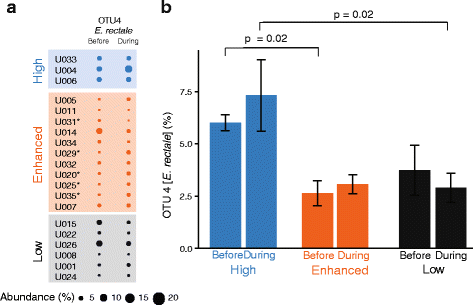Variable responses of human microbiomes to dietary supplementation with resistant starch
- PMID: 27357127
- PMCID: PMC4928258
- DOI: 10.1186/s40168-016-0178-x
Variable responses of human microbiomes to dietary supplementation with resistant starch
Abstract
Background: The fermentation of dietary fiber to various organic acids is a beneficial function provided by the microbiota in the human large intestine. In particular, butyric acid contributes to host health by facilitating maintenance of epithelial integrity, regulating inflammation, and influencing gene expression in colonocytes. We sought to increase the concentration of butyrate in 20 healthy young adults through dietary supplementation with resistant starch (unmodified potato starch-resistant starch (RS) type 2).
Methods: Fecal samples were collected from individuals to characterize butyrate concentration via liquid chromatography and composition of the microbiota via surveys of 16S rRNA-encoding gene sequences from the Illumina MiSeq platform. Random Forest and LEfSe analyses were used to associate responses in butyrate production to features of the microbiota.
Results: RS supplementation increased fecal butyrate concentrations in this cohort from 8 to 12 mmol/kg wet feces, but responses varied widely between individuals. Individuals could be categorized into three groups based upon butyrate concentrations before and during RS: enhanced, high, and low (n = 11, 3, and 6, respectively). Fecal butyrate increased by 67 % in the enhanced group (from 9 to 15 mmol/kg), while it remained ≥11 mmol/kg in the high group and ≤8 mmol/kg in the low group. Microbiota analyses revealed that the relative abundance of RS-degrading organisms-Bifidobacterium adolescentis or Ruminococcus bromii-increased from ~2 to 9 % in the enhanced and high groups, but remained at ~1.5 % in the low group. The lack of increase in RS-degrading bacteria in the low group may explain why there was no increase in fecal butyrate in response to RS. The microbiota of individuals in the high group were characterized by an elevated abundance of the butyrogenic microbe Eubacterium rectale (~6 % in high vs. 3 % in enhanced and low groups) throughout the study.
Conclusions: We document the heterogeneous responses in butyrate concentrations upon RS supplementation and identify characteristic of the microbiota that appear to underlie this variation. This study complements and extends other studies that call for personalized approaches to manage beneficial functions provided by gut microbiomes.
Figures





References
Publication types
MeSH terms
Substances
Grants and funding
LinkOut - more resources
Full Text Sources
Other Literature Sources
Medical
Miscellaneous

